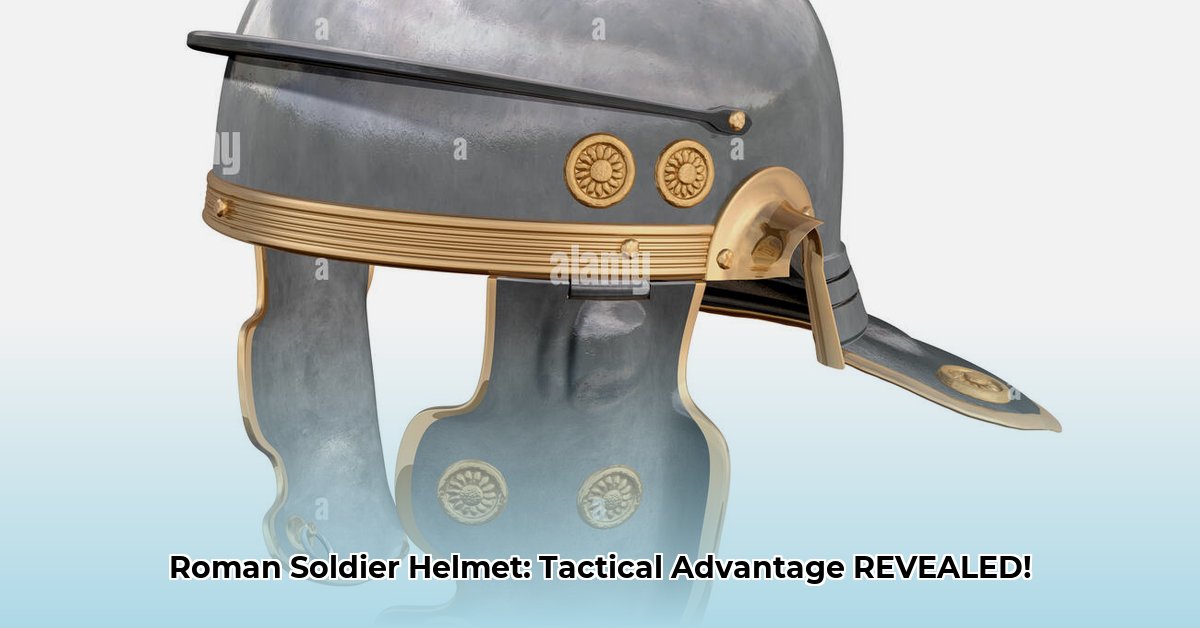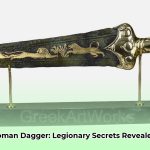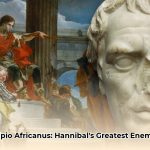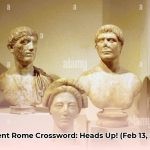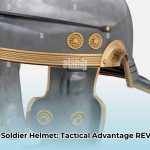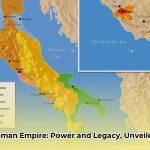Ever wonder what a Roman legionary was really contemplating as he faced down a screaming horde of barbarians, or marched for days under the relentless sun? While we can’t read minds, we can examine the very thing that topped their heads: the ancient Roman soldier helmet, known as the galea. Far more than mere protective gear, the galea was a profound symbol of identity and rank, a crucial tactical asset, and a living reflection of Rome’s ever-evolving military machine. A closer look at ancient Roman armor reveals even more about their kit.
From its humble, borrowed beginnings to its sophisticated imperial forms and its enduring legacy, the Roman helmet tells a gripping tale of constant adaptation. Driven by the brutal realities of the battlefield and the Romans’ uncanny knack for learning, innovating, and then imposing their will, the galea underwent remarkable transformations. This comprehensive guide will delve deep into the anatomy, evolution, and profound impact of these iconic headpieces, decoding how Roman army helmets revealed status, step-by-step identifying design changes influenced by crucial warfare, and unearthing essential insights into Roman helmet symbolism and legionary achievements. Prepare to master ancient Roman helmet design.
Anatomy of Authority: Key Features of the Roman Galea
The Roman helmet’s sophisticated design provided exceptional defense against a range of battlefield dangers, yet its construction often left the face exposed for critical visibility and communication. Its core components, which evolved over centuries, included:
- The Bowl: The main dome covering the top of the head, typically crafted from bronze or iron. Early bowls were simpler, while later models were more complex, sometimes segmented.
- Neck Guard (Flap): A crucial extension at the back of the helmet, flaring outwards to protect the neck from downward blows. Its size and shape varied significantly by helmet type.
- Cheek Guards: Hinged or fixed plates protecting the sides of the face and jaw from lateral attacks. These were often shaped to allow for ear exposure or covered by ear cutouts.
- Embossed Eyebrows: Prominent raised ridges above the eye openings, often decorative but also serving to reinforce the helmet’s structure and deflect blows.
- Crest Holder (Cristae): A fixture on the crown of the helmet, designed to hold decorative plumes or horsehair crests. These varied greatly in size and prominence, often signifying rank.
- Ventilation: Later designs sometimes incorporated small perforations or design elements that aided airflow, enhancing soldier comfort during prolonged wear.
Beyond mere practicality, the galea held deep symbolic significance, reflecting the soldier’s identity and status. Different helmet types, designs, and even the color and orientation of crests allowed for instant identification of officers, standard-bearers, and different military units on the chaotic battlefield.
A Journey Through Time and Tactics: The Evolution of Roman Helmet Designs
The story of the Roman helmet is a dynamic narrative of bronze giving way to iron, of borrowed designs becoming uniquely Roman, and of innovations born from sheer necessity.
1. The Borrowed Beginnings: Early Helmets and Celtic Influences
In Rome’s nascent days, its soldiers didn’t invent their headgear from scratch. They were practical, pragmatic, and remarkably adept at adopting what worked. Early Roman helmets, like the Etrusco-Corinthian and Attic styles, showed clear influences from their sophisticated neighbors, the Etruscans and Greeks. The Etrusco-Corinthian featured a distinctive nose guard and eye cutouts, while the Attic offered a more streamlined, rounded crown.
However, a true game-changer arrived around 300 BCE: the Montefortino helmet. This distinctive bronze piece, with its conical or rounded shape and a knobbed top for plumes, wasn’t originally Roman at all. It was Celtic. The Romans saw its simplicity and effectiveness and quickly made it their own. This wasn’t merely imitation; it was smart military procurement. The Montefortino, and its similar successor the Coolus helmet, were relatively easy to mass-produce from bronze, a critical factor for a growing Republic that needed to outfit legions rapidly. They provided fundamental protection for legionaries, enabling Rome’s early expansion and establishing a robust foundation for future soldier identification. The Coolus style, popular during Caesar’s Gallic Wars, often featured a smoother, more streamlined profile and an enhanced neck guard compared to its Montefortino predecessor, making it efficient for widespread deployment.
2. Republican Pragmatism to Imperial Innovation: The Agen and Port Styles
As Roman legions pushed across Italy and beyond, the demands on their equipment grew, leading to further Celtic-influenced innovations. The Agen and Port styles, developed during the Late Republic and Early Imperial periods (roughly 100 BCE – 100 CE), marked a significant shift. Unlike their bronze predecessors, these were among the first iron helmets widely adopted by the Romans, reflecting improvements in metallurgy.
The Agen style featured a deep, rounded bowl with a narrow brim flaring into a neck guard and distinctive embossed semi-circular eyebrows across the front – a feature that would become standard on later Imperial helmets. The Port style shared similarities but typically had a less pronounced brim and a more pronounced neck guard with prominent embossed ridges. These helmets showcased Rome’s increasing capacity for adapting foreign designs with native practicality, laying the groundwork for the iconic helmets of the high Imperial era.
3. Imperial Era Perfection: The Iconic Gallic and Italic Styles
The Imperial period heralded the pinnacle of Roman helmet design, best represented by the Imperial Gallic and Imperial Italic helmets, widely used from the 1st century CE onwards. Crafted predominantly from iron, these masterpieces offered vastly superior protection with their sturdy, often hinged cheek plates, deep neck guards, and often elaborate brow ridges.
The Imperial Gallic helmet, as its name suggests, incorporated elements of Celtic craftsmanship, recognizable by its distinctive embossed eyebrows, reinforced peak, and a pronounced neck guard that often featured horizontal ribs for added rigidity. Variants like the Imperial Gallic G were characterized by a reinforced brow and flared neck. These helmets were the quintessential headgear for legionaries, combining robust defense with practical design.
In contrast, the Imperial Italic helmet, likely manufactured in Italian workshops, often featured a simpler, more classical appearance. While sharing the general form of its Gallic counterpart, it typically had a more streamlined profile, sometimes lacking the prominent eyebrows or featuring different types of crest fixtures. Some surviving examples were made of bronze, suggesting they might have served ceremonial purposes or were favored by higher-ranking officers like centurions or the Praetorian Guard, whose greater purchasing power allowed for finer materials or bespoke designs. This period solidified Rome’s vast industrial capacity, enabling the production of standardized, yet regionally adapted, equipment on a massive scale.
4. Adapting to New Threats: The Dacian Wars and Reinforced Designs
Rome’s relentless expansion meant continuous encounters with new, formidable adversaries. The Dacian Wars, under Emperor Trajan in the early 2nd century CE, presented a particularly brutal challenge: the Dacian falx. This terrifying, curved sword could cleave through standard helmets and shields, demanding an immediate response. Roman helmet evolution directly impacted battlefield tactics in the face of such a specialized threat.
The answer was rapid innovation. Roman armorers quickly developed reinforced helmets, integrating heavy iron bars riveted across the skull, often forming a cross or ridge, to counter the falx‘s devastating power. This critical adaptation led directly to the development of ridged helmets, which offered enhanced protection against severe overhead blows. This period vividly illustrates Rome’s unparalleled ability to analyze new threats and rapidly implement effective countermeasures, showcasing their commitment to soldier protection and maintaining a tactical edge.
5. The Late Roman Transformation: Eastern Influences and the Spangenhelm Legacy
As the Roman Empire faced increasing pressures and its center of gravity shifted eastward, so too did its helmet designs. The Late Roman period (3rd-5th centuries CE) saw the rise of the ridge helmet, often influenced by Sassanid Persian and Steppe nomadic designs from the East. These helmets, like the Intercisa and Berkasovo types, were characterized by a prominent reinforcing ridge running along the crown, often constructed from multiple metal plates joined together.
The Intercisa helmet featured a composite bowl of two half-skulls joined by a central ridge. The more robust Berkasovo helmet (also known as the Heavy Ridge Type) had a bowl formed from two halves joined by heavy bands that ran front-to-back and along the rim, curving over each eye. Notably, the Berkasovo often incorporated a nasal guard, offering additional facial protection – a feature not common in earlier Roman designs. These robust, often decorated helmets, frequently covered with precious metals, are thought to have been favored by cavalry or higher-ranking officers.
The evolution culminated in the Spangenhelm, a modular helmet that would define warrior headgear for centuries across Eurasia. Constructed from several metal segments (typically four to six plates) riveted to a framework of bands, topped by a circular disc, the Spangenhelm offered ease of repair and possibly lower production costs, crucial factors in a sprawling empire managing resource strains and supply lines. Its widespread adoption, even influencing barbarian and medieval European armies well into the 8th century, underscores Rome’s enduring legacy in military equipment far beyond its political decline.
Materials, Craftsmanship, and the Forge of Empire
Roman helmets were masterworks of ancient metallurgy and craftsmanship. Early helmets were predominantly cast and hammered from bronze (an alloy of copper and tin), chosen for its relative ease of working and durability. As metallurgical knowledge advanced, iron became the preferred material for its superior strength and protective qualities, especially for Imperial era helmets. Some elite helmets, particularly during the late empire, were crafted from iron and then sheathed in more valuable metals like silver or gold for decorative or ceremonial purposes.
The typical manufacturing process involved hammering a single sheet of metal into the desired bowl shape (for earlier types) or forging multiple plates and riveting them together into a composite structure (for later types like the Spangenhelm). Cheek guards were often separately forged and then hinged or riveted to the main bowl. Crests were attached using various methods, including metal sockets, riveted supports, or leather straps, allowing for interchangeability. Roman armorers were highly skilled, capable of producing millions of helmets over centuries, each designed to meet the rigorous demands of the Roman military machine.
Symbolism, Rank, and Psychological Warfare: The Galea’s Deeper Meaning
The ancient Roman soldier helmet was never merely a piece of metal; it was a dynamic tool of war, a symbol of rank and unit cohesion, and a psychological weapon against the enemy.
Identity and Rank Markers
Different types of helmets were often associated with various ranks. While legionaries wore standardized helmets, high-ranking officers like centurions, tribunes, and legates regularly sported more ornate versions. Crests (cristae) were the most prominent visual indicator of rank and unit affiliation. Made of horsehair or feathers, these striking adornments were often dyed in different colors (red, black, white) and could be worn vertically (transverse crests for centurions) or longitudinally. The size and elaborateness of the crest further distinguished ranks within the centurionate and other commands, instantly signaling authority on the battlefield. The very act of wearing a helmet that represented their unit or rank fostered a profound sense of pride and collective identity among soldiers, reinforcing their commitment to comrades and their shared mission.
Psychological Impact: Friend and Foe
The psychological impact of Roman helmets cannot be overstated. For allies and fellow legionaries, the sight of a unified legion, their disciplined ranks topped by gleaming, uniform helmets, created an immediate sense of unity, camaraderie, and invincibility. It instilled confidence and bolstered loyalty, especially when recognizing a comrade from a distance in the midst of battle.
On the other hand, the effect on opponents was often more striking. The intimidating appearance of Roman helmets, particularly those with bold crests and stern embossed eyebrows, struck fear into the hearts of enemies, steadily damaging their morale. This visual prowess effectively functioned as an additional Roman army tactic. Beyond the battlefield, Roman helmets became synonymous with the might and invincibility of the Roman Empire. The reputation of a Roman soldier, at one point, was so intimidating that opponents sometimes surrendered without a fight, with the instantly recognizable galea being a key factor in this psychological dominance.
Unearthing History: Archaeology, Reconstruction, and Modern Study
Our understanding of Roman helmets is largely based on painstaking archaeological discoveries, which provide invaluable insights into their design, construction, and use. Notable finds include:
- The Hedderheim Helmet (Germany): A remarkably well-preserved Montefortino helmet, showcasing the conical shape and nasal guard typical of early designs.
- The Debjerg Helmet (Denmark): A rare Roman helmet found outside the empire’s borders, highlighting the far reach of Roman military and cultural influence.
- The Newstead Helmet (Scotland): A cavalry helmet from the 1st century CE, richly decorated and providing insights into the specialized equipment of mounted troops.
- The Crosby Garrett Helmet (England): A highly ornate 2nd-century CE Roman cavalry helmet (parade helmet) found in 2010, intricately decorated with mythological scenes, demonstrating exquisite Roman artistry and the ceremonial role of some helmets.
The preservation of these artifacts presents significant challenges, as many are found in fragmentary or corroded states. Advances in archaeological science, such as X-ray fluorescence and 3D scanning, have greatly aided in their study and documentation. Furthermore, experimental archaeology and reconstructions have become vital tools. By recreating helmets using period-accurate materials and techniques, researchers and reenactors test their effectiveness against historical weapons, gaining practical insights into their protective capabilities, production methods, and the experience of wearing them in combat.
Enduring Legacy in Lore and Modernity
The impact of Roman helmet designs extends far beyond the fall of the empire, influencing military headgear for centuries to come and captivating popular culture.
Influence on Military Design
The Spangenhelm, a Roman innovation, saw extensive use in Byzantine and Medieval European armies, showcasing the enduring influence of Roman military technology. Its modular, robust design became a template for subsequent helmet development across the continent. Even in the 19th and 20th centuries, the iconic Roman legionary helmet served as a symbolic model for the helmets of various European armies, with echoes seen in designs like the French Army’s Adrian helmet or the German Stahlhelm, reflecting a desire to evoke the strength and discipline of Rome.
Cultural Iconography
In modern popular culture, the image of the Roman helmet has become synonymous with the might and discipline of the Roman military.
- Film and Television: From epics like ‘Gladiator’ showcasing the iconic Imperial Gallic helmet to historical dramas like ‘Rome’ meticulously recreating authentic atmospheres, Roman helmets are a central visual element, reinforcing the powerful image of the Roman army.
- Comics and Literature: In graphic novels like ‘Asterix,’ Roman soldiers are famously depicted wearing classic crested helmets, even in humorous contexts, cementing their visual identity.
- Sports Teams: The formidable image of the Roman helmet has been adopted by numerous sports teams worldwide to evoke strength, valor, and competition. American football teams like the Tampa Bay Buccaneers and the Denver Broncos have incorporated Roman helmet-inspired designs into their logos and uniforms. The Italian football club AS Roma features a logo that incorporates the Roman wolf with two small figures wearing helmets, representing the city’s ancient Roman heritage. The Columbus Blue Jackets hockey team also utilizes a Roman-style soldier’s helmet in their emblem.
Conclusion: The Silent Sentinels of Roman Might
The journey through Roman helmet designs reveals far more than just technological advancements. It tells a compelling story of adaptation, cultural exchange, and strategic evolution that consistently informed legionary identity and achievements.
| Feature | Early Helmets (e.g., Montefortino, Coolus) | Imperial Era Helmets (e.g., Imperial Gallic, Italic) | Late Roman Helmets (e.g., Ridge, Spangenhelm) |
|---|---|---|---|
| Material | Bronze (less commonly Iron) | Iron (less commonly Bronze for elite) | Iron, Composite Plates, Sheathed Metals |
| Design Focus | Simplicity, Mass Production, Conical | Enhanced Protection, Standardized, Robust | Functional, Modular, Segmented, Eastern Influences |
| Key Features | Knobbed apex, simple neck/cheek guards | Embossed eyebrows, reinforced peaks, hinged cheek guards | Central ridge, composite bowl, nasal guards, multi-plate construction |
| Cultural Impact | Celtic/Greek influences, early expansion | Roman/Gallic craftsmanship, empire consolidation | Sassanid/Steppe influences, widespread legacy in Medieval Europe |
| Battlefield Role | Basic protection, early expansion | Superior defense, large-scale conquest, standard equipment | Adaptability to diverse threats (e.g., falx), increasing cavalry use |
The ancient Roman soldier helmet, the galea, was never merely a piece of metal. It was a dynamic tool of war, a symbol of rank and unit cohesion, and a potent psychological weapon. The very sight of a Roman legion, their helmets gleaming under the sun, often broke enemy morale before a single javelin was thrown.
As archaeological research continues to unearth new examples and provide fresh insights, our understanding of these iconic artifacts will only deepen. The next time you see a Roman soldier helmet, remember that you’re looking at more than just a relic. You’re looking at a tangible piece of Roman power, ingenuity, and the enduring legacy of a civilization that meticulously crafted its way to military dominance, one galea at a time.
